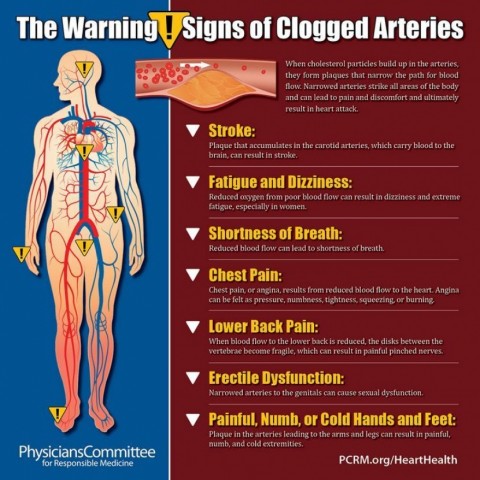DrCarney.com Blog
Can Lower Back Pain be a Warning Sign of Clogged Arteries?
Do you suffer from lower back pain? If so, you're not alone. Low back pain is the second leading cause of disability in Westernized countries with a lifetime prevalence of 84%. Chronic low back pain afflicts 1 in every 5 people and 1 in 10 experiences disabling back pain. Although there are multiple factors which influence disc degeneration such as obesity and genetic, occupational, and mechanical influences; narrowed or blocked blood vessels is an often overlooked factor. Dr. Michael Greger's above video demonstrates how "atherosclerosis can obstruct the arteries that feed the spine and this diminished blood flow can result in the various back problems." He says that cholesterol-filled blockage of the spinal arteries can be seen on angiography or during an autopsy. (See the below photo.) Because these plaques are found throughout our entire vascular system, back pain may be a warning sign of advancing heart disease just like erectile dysfunction.
One reason why back pain is a common condition is because the discs themselves don’t have any blood vessels, this makes them very vulnerable to deprivation. There are however, many vessels surrounding these discs. Consequently, "its nutrition just kind of diffuses in from the margins" Dr. Greger says. "By age 49, 97% of the discs of those eating the standard American diet show at least grade 2 degradation." MRI imaging shows the occlusion of spinal arteries in people with back pain and the degeneration of the discs. "They showed that patients with long-term lower back pain had these kinds of occlusions, and those with high cholesterol appeared to suffer with more severe symptoms. Those with narrowed arteries appear about 8 and a half times more likely to have suffered from chronic back pain."
Watch Dr. Greger's video "Back in Circulation: Sciatica and Cholesterol" below:
Dr. Greger explains in detail stating that, "Cholesterol plaques in the wall of the aorta obliterate the orifices of lumbar and middle sacral arteries and may decrease blood supply of the lumbar spine and its surrounding structures. Structures with precarious nutrient supply, such as the intervertebral discs, may suffer and gradually degenerate, as well as herniate. Not only is there a relationship between cholesterol levels and disc degeneration there’s an association between cholesterol levels and disc herniation. This compromised blood flow may also damage the nerve roots that come off the spine, causing sciatica. Clinical sciatica may be associated with cholesterol as well. The nerve roots (which are most commonly associated with sciatic pain) are supplied by some of the arteries most vulnerable to atherosclerotic plaque formation. Obliteration of these arteries by cholesterol buildup results in compromised nutrient supply to the nerve itself. And that lack of oxygen to the nerve may be playing a role in sciatica pain. Reduced blood flow also hampers the removal of waste products, such as lactic acid, which can in turn irritate the nerve endings, causing pain and deterioration."
Due to decreased blood flow, the discs in the back degenerate faster than musculoskeletal tissues. The beginning stage of degeneration has been seen in children as early as 11 years of age, and is commonly seen in the majority of teens. This discovery confirms the evidence showing that the majority of children begining at age 10 have the beginning stages of atherosclerosis. For this reason, many children and teens are suffering from lower back pain, along with other conditions that only adults once suffered from like type-2 diabetes, stroke, obesity, sleep apnea, hypertension, and heart disease.
Autopsy findings demonstrate how the vessels leading from the aorta to the vertebral discs become clogged with fatty cholesterol. In the video below you will see side by side photos of a section of an aorta during autopsy. The vessels on the left are open, but the ones on the right are filled with cholesterol plaques. These atherosclerotic plaques in the aorta are seen in young adults by the age of 20 with 10% of young adults having advanced lesions. Doctor Greger addresses this in his one-minute video. He emphasizes that "smoking and high cholesterol levels were found to have the most consistent associations with disc degeneration and lower back pain."
Watch Dr. Greger's video on "Cholesterol and Lower Back Pain" below:
Additional Information:
(1) Who has Heart Disease? Everyone?
Michael Greger MD Links
Scroll Down Page to Leave Comments

Got Questions?
We would love to receive your questions. Join in the Starch-Smart Discussions on DrCarney.com by signing up for a free membership to the Dr. Carney Community.
Preview the "Diabetes in Retreat" Trailer
No More Meds?: Got a family history? Outsmart it! Decrease your need for medication naturally with Dr. Carney. Her patients can REVERSE Diabetes Type II. Which foods worsen insulin resistance? Find out now. Get the keys to lowering your insulin resistance with her proven methods for success. Finally, an MD who helps even Type 1 diabetics reduce insulin requirements using her Starch-Smart® System, a science-based plan to help you normalize weight and blood sugars.
When you subscribe to the blog, we will send you an e-mail when there are new updates on the site so you wouldn't miss them.




